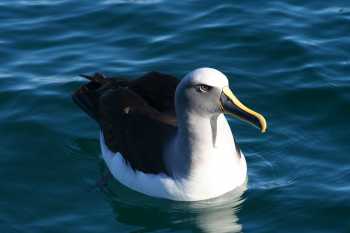Paul Sagar, Leigh Torres and David Thompson of the National Institute of Water & Atmospheric Research (NIWA) have studied the demography and distribution of the Near Threatened Buller's Albatross Thalassarche bulleri at New Zealand's Snares Islands.
Information in their 2010 field season report is given on breeding population size and productivity, adult survival and survival and recruitment of known-age birds, and foraging and at-sea movements using 60 geolocation loggers deployed in 2008 and 2009. The main aims of the project were to build upon the comprehensive demographic database for Buller's Albatrosses and to determine at-sea distribution of over periods for which data are currently lacking, so that information would become available for the whole annual cycle for the first time.
Initial analysis of the geolocator data shows that during November all birds were distributed off the coasts of Chile and Peru; during December, January and February there was movement west across the Pacific as breeding birds returned to Australasian waters for the start of the breeding season. In April, during the guard-stage of the chick, most breeding birds confined their foraging within New Zealand's Exclusive Economic Zone, primarily over the Snares Shelf and farther south. In May, after the guard-stage, foraging extended primarily off the east coast of the South Island of New Zealand. There was some movement of birds east across the Pacific, presumably following the death of their chick. During July, breeding birds continued to forage off the east coast and there was also an increase in foraging off the west coast of South Island. Failed breeders foraged primarily off the coast of Chile. By August there was a contraction of the foraging range along the east coast of South Island and the movement of presumed successful breeders east across the Pacific. The last birds migrated across the Pacific to South American waters during October.
Reference:
Sagar, P., Torres, L. & Thompson, D. 2010. Demography and Distribution of Buller's Albatrosses Thalassarche bulleri bulleri: Final Research Report of the 2010 Field Season. Christchurch: National Institute of Water & Atmospheric Research. 10 pp.

John Cooper, ACAP Information Officer, 4 August 2011

 Français
Français  English
English  Español
Español